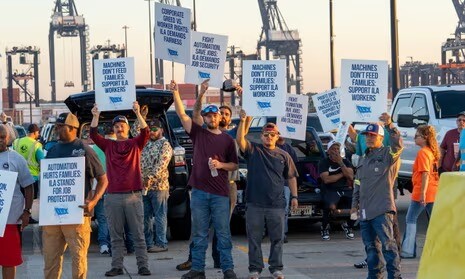
A crucial agreement has been reached between US port workers and operators, bringing an immediate end to the East Coast strike that has disrupted shipping and supply chains in the region. The deal marks a significant development in the labor dispute that had caused major disruptions at some of the nation’s busiest ports, threatening the flow of goods and impacting industries across the United States.
Background on the Strike
The strike, which involved thousands of dockworkers at key East Coast ports, began over concerns related to wages, working conditions, and job security. Negotiations between the International Longshoremen’s Association (ILA), representing the workers, and the United States Maritime Alliance (USMX), which represents shipping companies and terminal operators, had been ongoing for months. However, tensions escalated as talks stalled, leading to the walkout and subsequent work stoppage at multiple ports, including New York, New Jersey, and Savannah.
Key Points of the Deal
The agreement reached between the two sides addresses the main points of contention, including increased wages, better working conditions, and job security measures for dockworkers. Both the ILA and USMX have expressed satisfaction with the terms of the deal, noting that it provides fair compensation for workers while ensuring the smooth operation of port facilities.
A major component of the deal includes investments in automation and technology at the ports, something that had been a sticking point in negotiations. Workers had feared that increased automation would result in job losses, but the new agreement reportedly includes guarantees to protect jobs while allowing for modernization efforts.
Impact on the US Supply Chain
The strike had caused significant delays in the flow of goods, leading to bottlenecks in the supply chain and concerns about shortages in several industries, including retail, manufacturing, and agriculture. With the strike now resolved, port operations are expected to resume at full capacity, allowing for the clearance of backlogged shipments. This is particularly important as the US approaches the busy holiday season, when demand for imported goods is at its highest.
Response from Industry and Government
Industry leaders and government officials have welcomed the resolution of the strike, expressing relief that a deal has been reached without the need for prolonged disruptions. The Biden administration had been monitoring the situation closely, as the strike threatened to exacerbate existing challenges in the US supply chain.
The US Chamber of Commerce, along with various trade organizations, also praised the agreement, noting that a prolonged strike would have had severe economic consequences. With ports now returning to normal operations, businesses across the country are hopeful that the impact on supply chains will be minimized.
Looking Ahead
While the immediate crisis has been averted, the agreement between port workers and operators signals the need for ongoing discussions about the future of labor and automation in the shipping industry. Both sides will need to continue working together to address concerns about technological advancements while ensuring that workers’ rights are protected. For now, the resolution of the strike marks a positive step toward stability in one of the US’s most critical economic sectors.
Subscribe to Follow Global Trends for daily global news.
Find Out How To Make Money As A Full Time Writer/Blogger Guide.
To Advertise, Advertise Your Affiliate Links on FollowGlobalTrends.com for Just $1 Per Link Per Month!
Related Articles
The International Longshoremen’s Association (ILA): Championing Workers’ Rights in the Maritime Industry
The United States Maritime Alliance (USMX): Representing Employers in the Shipping Industry
US Port Workers and Operators Reach Deal to End East Coast Strike
The East Coast of the United States: A Vital Region for Trade and Economy
Written By Fortune Davidson
